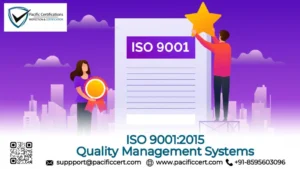
ISO 9001:2015 is the most widely used international standard for managing quality in day to day business. It gives organizations a clear structure for planning work, controlling risks and making sure customers receive consistent products and services. Whether you are a small service provider or a large manufacturer, ISO 9001:2015 helps you put order into processes that may currently depend only on people and habits.
At the heart of ISO 9001:2015 is your Quality Management System, or QMS. This is the framework of policies, procedures and records that describe how you work. When the QMS is aligned with ISO 9001:2015, teams understand their roles better, problems are found earlier and customers see fewer errors or delays. Over time this builds trust and supports repeat business.
Planning ISO 9001 Certification Cost for ISO 9001:2015
Many organizations start their journey by asking about ISO 9001 Certification Cost. The investment depends on factors such as number of staff, locations, the scope of activities and how mature your existing system is. If you already follow clear procedures and keep records, the transition to ISO 9001:2015 may be quicker and ISO 9001 Certification Cost may be lower compared to a business that is starting from scratch.
It is helpful to see ISO 9001:2015 as more than a one time expense. A well planned project can reduce waste, rework and customer complaints. When these issues go down, the long term savings often outweigh the initial ISO 9001 Certification Cost. Management should treat certification as a project that supports growth rather than just a badge for marketing.
Key influences on ISO 9001 Certification Cost
ISO 9001 Certification Cost is shaped by audit days and preparation effort. Larger organizations need more audit time so that auditors can review processes, visit sites and speak with people in different functions. Highly regulated sectors also tend to need more evaluation because of the risks linked to their products or services.
Internal factors matter as well. If processes are not documented, if records are scattered or if staff are unaware of ISO 9001:2015, then more time is required to set things in order. On the other hand, when management commits early, assigns clear responsibilities and tracks progress, the project moves steadily and avoids extra hidden cost.
ISO 9001 Training and your Quality Management System
ISO 9001 Training is one of the strongest ways to bring your Quality Management System to life. People who understand ISO 9001:2015 can relate the clauses of the standard to their daily tasks. This creates ownership and reduces resistance to change. Training can be carried out for top management, process owners and teams who handle documentation and internal audits.
Well structured ISO 9001 Training explains why the standard asks for certain controls instead of only showing what to fill in on forms. When staff see how ISO 9001:2015 links customer needs, risk based thinking and process control, they are more willing to use the QMS as a daily tool rather than a filing exercise for auditors.
ISO 9001 Training paths under ISO 9001:2015
ISO 9001 Training can take many forms. Awareness sessions give an overview of ISO 9001:2015 for all staff so they see the big picture. Implementer training goes deeper into clauses, process mapping and risk based planning so that key people can build or upgrade the QMS. Internal auditor training teaches staff how to audit departments, ask the right questions and write useful findings.
When organizations invest in the right level of ISO 9001 Training, they create in house knowledge instead of depending only on external support. This knowledge helps maintain the QMS year after year and keeps it aligned with ISO 9001:2015 as the business grows or changes.
Linking ISO 9001 Training and ISO 9001 Certification Cost with your Quality Management System
There is a direct connection between ISO 9001 Training, ISO 9001 Certification Cost and the strength of your Quality Management System. If people are trained well at the start, they make fewer mistakes in documentation and implementation. This reduces the risk of major nonconformities during the audit and can avoid the need for extended audit time, which would increase ISO 9001 Certification Cost.
A balanced project will set a clear plan for ISO 9001:2015, allocate time and budget for ISO 9001 Training and then manage ISO 9001 Certification Cost as part of the overall quality improvement journey. The result is a QMS that supports customers and business goals instead of existing only for a certificate on the wall.
Conclusion
ISO 9001:2015 gives organizations a practical way to bring order, consistency and clarity into everyday work. When you look at ISO 9001 Certification Cost and ISO 9001 Training together, it becomes clear that both are investments in long term stability and customer trust. With a well built Quality Management System, your business can handle growth with fewer errors and greater confidence in its processes.
FAQs on ISO 9001:2015
Q1. What type of organizations can apply for ISO 9001:2015?
Any organization that provides products or services can apply for ISO 9001:2015. It is suitable for manufacturing, services, public sector bodies, start ups and large corporations.
Q2. How long does it usually take to get certified to ISO 9001:2015?
The timeline depends on current practices and size. Many organizations take six to twelve months to fully design, implement and audit their Quality Management System.
Q3. Is ISO 9001 Certification Cost the same for all companies?
No. ISO 9001 Certification Cost varies with staff strength, number of sites, scope and the level of process control already in place.
Q4. Why is ISO 9001 Training important for staff?
ISO 9001 Training helps people understand their roles in the Quality Management System, which leads to fewer mistakes and smoother audits against ISO 9001:2015.